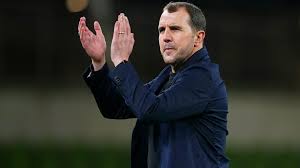
John O’Shea will come away from his first two games as a head coach with mixed emotions. A genuinely impressive performance against a much-changed Belgium side saw the former Manchester United man put together a well-drilled XI that had a good mix of youth and experience who diligently carried out their instructions, particularly when they didn’t have the ball. Very much a promising rookie in the coaching sphere, Stephen Kenny’s former assistant can therefore be forgiven for perhaps being tactically out-thought by his opposite number in the dugout, Murat Yakin, when Ireland took on Switzerland on Tuesday night. With a 437 game head start as a manager, Yakin definitely showed the value of experience at this level, and will give the Waterford native lots to ponder and learn from.
In his own words earlier this month “We will be able to mix it up when we need to, play when we need to and fight when we need to. It will be a mixture of everything.” This mantra was on display less than 3 minutes into O’Shea’s reign, when Robbie Brady clipped the ball forward to Evan Ferguson who battled hard against the challenge of Wout Faes. He laid it off to Josh Cullen who smartly picked out the debutant Sammie Szmodics, with the Championship’s top-scorer playing a penetrative through-ball to Chiedozie Ogbene, who should have squared it to returning captain Seamus Coleman to get Ireland off to a dream start. It showed possession with intent, using Ferguson’s strength to bring others into the game and quickly attacking the space.
Arguably, the most impressive aspect of that performance against the Belgians was Ireland’s out of possession strategy. We saw two key elements to Ireland’s press: A disciplined 5-4-1 low-block and a higher, man-to-man structure when Tedesco’s men were forced back.
When Belgium established possession in Ireland’s half they were often met with a stubborn bank of five and four while Brighton’s Ferguson pivoted over and back looking to force play to one side.
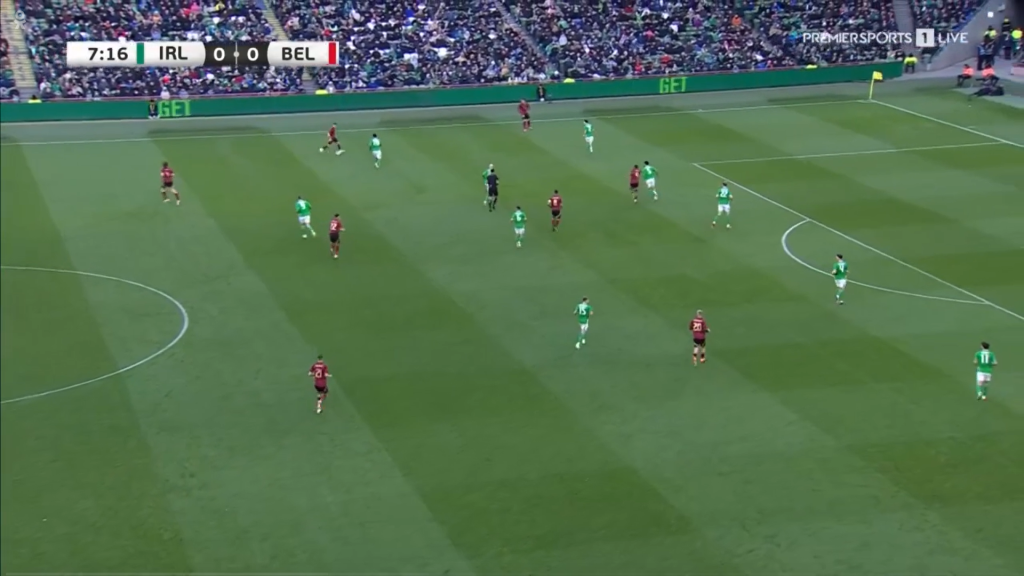
There were certain triggers which meant Ireland would jump out of their low block, such as a backwards pass, as this was an opportunity to dictate the direction and tempo of play without having possession of the ball.
In the above clip, Wout Faes’ pass back to De Winter triggers Ferguson to jump out into a curved press from out to in. This particular pressing technique is used as De Winter is the central player in Belgium’s 3-1 build-up shape, so Ireland’s number 9 can force the ball towards Timothy Castagne on the right of the 3, meaning that Sammie Szmodics can get a head start and aggressively press the Fulham man, whose only realistic option for a pass at this point is Vermeeren in the right wing-back position.
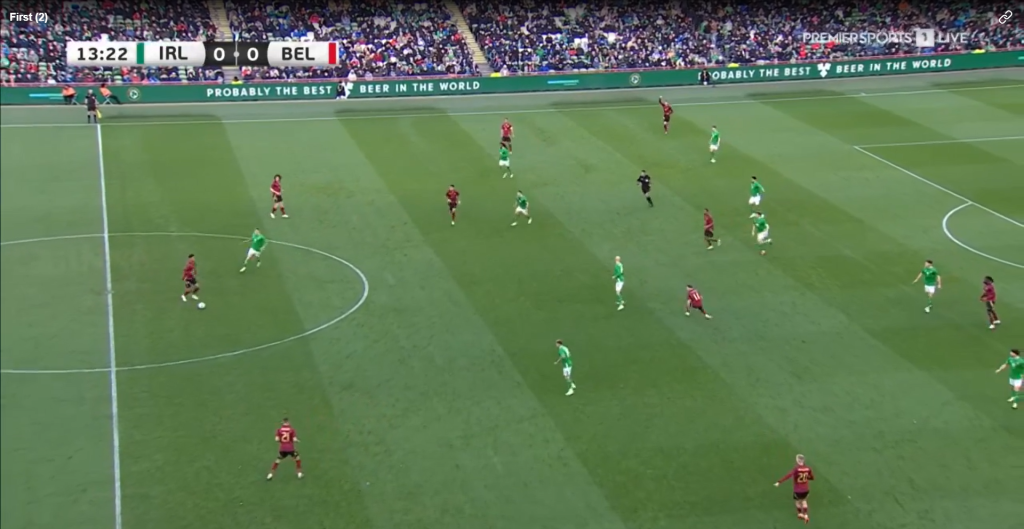
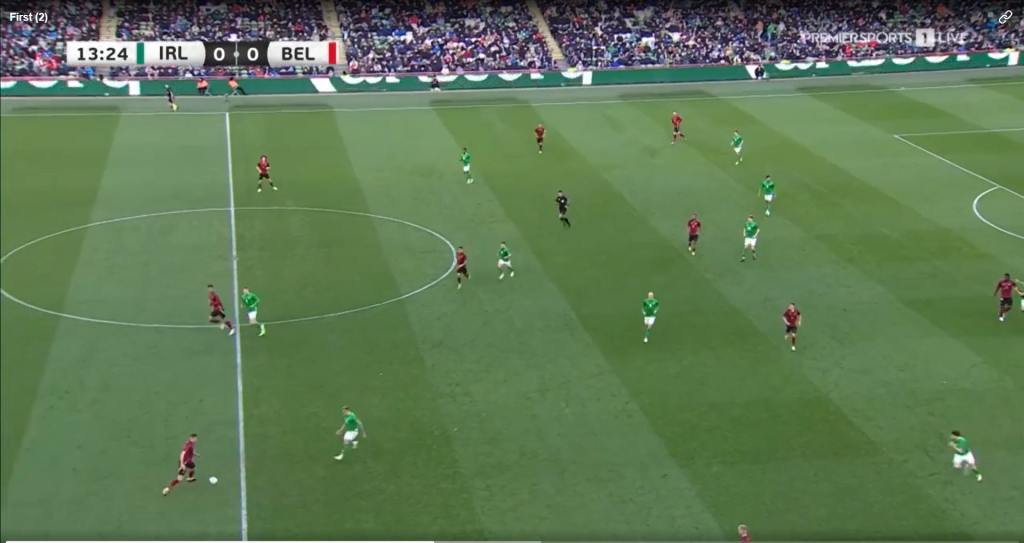
From here, Ireland are now man-to-man on this side of the pitch, significantly limiting Belgium’s options and forcing them into a higher tempo one touch passing sequence, leading to single pivot Vranckx losing possession and Ireland regaining it.
In the second game, Ireland found it much more difficult to win the ball back in this manner due to Switzerland creating overloads in key areas. In the below clip, Shaqiri starts the phase by occupying the Irish back line and slowly drops to form a ‘box’ shape midfield, which keeps Ireland narrow as they look to prevent central progression. Aebischer pulls out to the left wing-back position to join the same vertical line as Ndoye who is pinning Robbie Brady back. Aebischer can then receive in the wide channel in space which forces Ireland back behind the ball and allows Switzerland to progress further up the field.
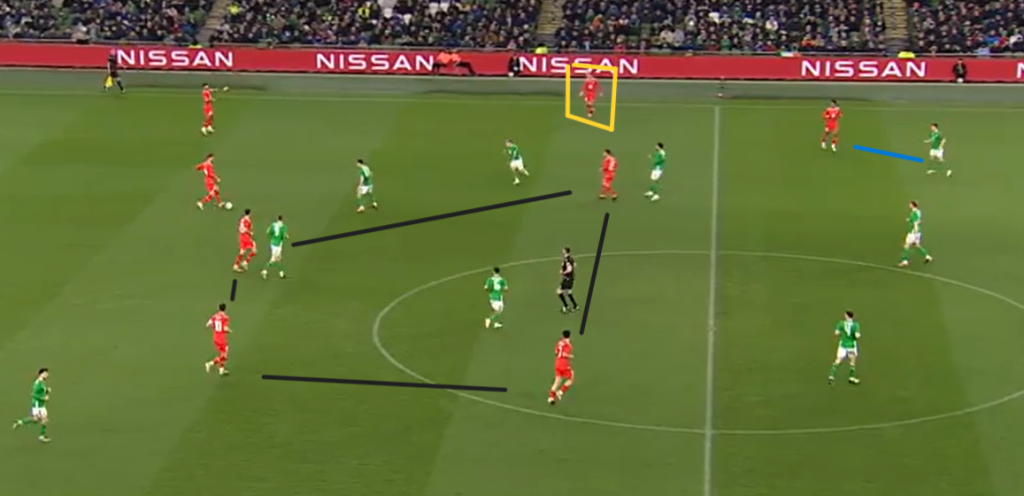
This trend continued throughout the first half in particular and was one of the reasons why it seemed like Ireland simply could not impose themselves on the Swiss.
In both games, Ireland used the same triggers to spring out of a mid-block to a high press, with mixed results. The narrow 5-4-1 shape prevented Belgium progressing the ball through central areas with the two wide men, Ogbene and Szmodics, tucking in to block passing channels to the wider of the three opposition midfielders. The idea was to tempt Belgium into playing the ball to their widest men, where Ireland’s wing backs, Brady and Coleman, could then jump out and press the receiver, forcing him backwards. This was the catalyst for the Irish to switch into a man-to-man high press, once again governing the direction and tempo of play without even touching the football. Switzerland clearly identified this facet of Ireland’s out of possession tactics and were able to negate it.
Very early on against the Swiss Ireland were successful in forcing them back and winning the ball high.
However, much like what is seen at the elite level these days, Switzerland began to bait Ireland’s man-to-man high press and use it to their advantage. They dragged the Irish players towards the ball and then played over or through to a Swiss forward and from there they could quickly take advantage of the space that was left from Ireland pressing high.
In game one, on the few occasions the Belgians managed to breach the blockaded central channels, one of Ireland’s three centre-backs was on hand to quickly step up and snuff it out or force the ball back the way it came. In the below clip, De Winter spots a direct route to Openda but Dara O’Shea, who was excellent throughout, anticipates it and steals it off the Leipzig man with some interest. It summed up the intensity and organisation of Ireland’s game plan when they didn’t have the ball.
Against Switzerland, like much of Ireland’s out of possession strategy, the opposite happened. The Swiss midfield and forward lines were very fluid, constantly interchanging their positions between the lines, leaving lots of confusion between Ireland’s midfield and back lines. Burnley’s Zeki Amdouni in particular caused havoc as he regularly floated inside from his right-wing position, ending up on the left side at times. In the first clip below, it’s Nathan Collins who is dragged deep into the Swiss half as Ireland are outnumbered.
Earlier in the first half, Switzerland’s overload on the right side meant Amdouni received it unopposed, with confusion amongst O’Shea’s men as to who should pick him up.
In possession against Belgium in particular, a key element of Ireland’s attack was utilising Evan Ferguson’s physical strengths. Be it through bringing others into play like the first clip in this piece showed, winning flick-ons, winning the second ball or just getting the Brighton man and others into the box anticipating the cross from Robbie Brady, it was simple, yet most importantly, effective.
In the second game, Ferguson was again a useful outlet, giving Ireland a man to play off of and launch an attack. In a game where Ireland failed to create a single ‘big chance’, it was a strategy which brought them the most joy.
There was another important component of Ireland’s attack in the first game that had been missing during some of Ireland’s painstakingly slow periods on the ball towards the end of the Euro 2024 campaign: Possession with purpose. Ireland had clearly been instructed to be more penetrative and efficient with the football, often by-passing the midfield duo of Smallbone and Cullen and targetting the forwards early. Nathan Collins, a technically gifted centre-back, led the charge in this regard without forcing the issue. In part one of the below clip, the Brentford man notices his team are underloaded in the area where he initially receives the ball, so he remains calm and plays it back to Caoimhin Kelleher. In the next phase of that build-up, the Belgians have been forced to retreat, and Collins has time and space to get his head up and play an excellent cross-field ball to Chiedozie Ogbene, who is now one versus one in the final third. In part two of the clip, he wastes no time in hitting Sammie Szmodics in the pocket, breaking the opposition’s midfield line in the process. Ireland showed an ability to remain calm when the more ‘direct’ option wasn’t on but to quickly make the furthest pass forward when they could.
With Mark Canham’s date of early April for the unveiling of a new permanent manager fast approaching, the March window has given fans glimpses of what we want to see from this side, as well as stark reminders of what we desperately need to see from Kenny’s successor. For a while now there has been whispered votes of confidence in this squad, but it feels like the next step is getting a manager who has been around the block and knows how to get the best out of a promising group.
(Clips taken from Premier Sports)
Are the FAI so blind they can not see, the interim manager did a excellent job in the very short time he had with the team, it’s just typical other FAI to dump O’Shea immediately after the team for once in the last few years looked like they knew what was expected from them and they don’t look like it’ll be long before they deliver, + keep Kerr in the mix he has a wise owl football brain.⚽🇮🇪☘️
They scored no goals in 180 minutes. One loss and a draw in 2 home fixtures is not exactly impressive.
Wow, superb blog layout! How long have you been blogging
for? you make running a blog look easy. The full
look of your website is magnificent, as well as the content material!
You can see similar here sklep online
Wow, superb weblog layout! How lengthy have you ever been blogging for?
you made running a blog glance easy. The whole look of your website is magnificent, let alone the content!
You can see similar here najlepszy sklep